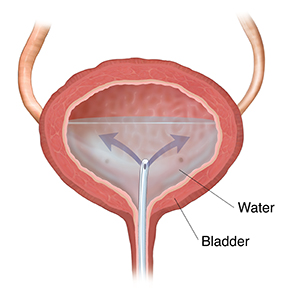Treating Interstitial Cystitis: Medicine
Treating Interstitial Cystitis: Medicine

Oral medicines
Your healthcare provider may give you one or more of these. Ask your healthcare provider about all of your options.
Pain medicine. These may be used for a short time to help ease discomfort.
Antispasmodic medicines. These may help relax the bladder muscles. This may decrease the need to urinate.
Nonsteroidal anti-inflammatory drugs (NSAIDs). These may help reduce inflammation and ease pain.
Antihistamines. These may help reduce inflammation and ease pain.
Antidepressants. In low doses, these may block pain and help ease symptoms.
Pentosan polysulfate sodium (Elmiron) and similar medications. These can restore the bladder lining.
Bladder instillation
Bladder instillation is also called bladder wash or bath. It may help relieve your inflammation. It may help repair the bladder’s lining. During the treatment, the bladder is filled with liquid medicine. This is done with a thin tube (catheter). One or more types of medicine may be used. You will hold the medicine in your bladder for 15 to 30 minutes. Then you will urinate. Or the medicine is drained out through the catheter. This treatment is repeated over 2 to 3 months. In some cases, they may be done at home.
Bladder hydrodistention
Hydrodistention is a procedure to stretch the walls of the bladder. It is done by filling the bladder with fluid. You may have had this procedure to diagnose your interstitial cystitis. Some people have relief from symptoms for a time afterward. If this was true for you, your doctor may repeat the procedure as a treatment.
Updated:
March 20, 2017
Reviewed By:
Goode, Paula, RN, BSN, MSN,Greenstein, Marc, DO,Image reviewed by StayWell medical illustration team.